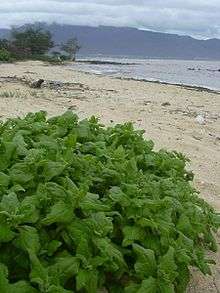Tetragonia
| Tetragonia | |
|---|---|
 | |
| Tetragonia tetragonoides | |
| Scientific classification | |
| Kingdom: | Plantae |
| (unranked): | Angiosperms |
| (unranked): | Eudicots |
| (unranked): | Core eudicots |
| Order: | Caryophyllales |
| Family: | Aizoaceae |
| Genus: | Tetragonia L. |
| Species | |
|
About 50-60 species, including:
| |
Tetragonia is a genus of 50–60 species of flowering plants in the family Aizoaceae, native to temperate and subtropical regions mostly of the Southern Hemisphere, in New Zealand, Australia, southern Africa and South America.
Description
Plants of the Tetragonia genus are herbs or small shrubs. Leaves are alternate and succulent, with flowers typically yellow and small . Fruit are initially succulent but become dry and woody with age. The genus name comes from "tetragonus", meaning "four-angled" and referring to the shape of the plants' fruits.[1]
Human use and cultivation
The best known species of Tetragonia is the leafy vegetable food crop, Tetragonia tetragonioides ("New Zealand spinach"). New Zealand spinach is widely cultivated as a summer leafy vegetable.
Some of the other species are also eaten locally, such as Tetragonia decumbens ("Dune spinach") which is a local delicacy in its native southern Africa.[2]
References
- ↑ Beadle, N.C.W., Part II, Students Flora of North Eastern New South Wales, University of New England, 1972, ISBN 0-85834-040-2.
- ↑ http://www.plantzafrica.com/planttuv/tetragondec.htm
| Wikimedia Commons has media related to Tetragonia. |